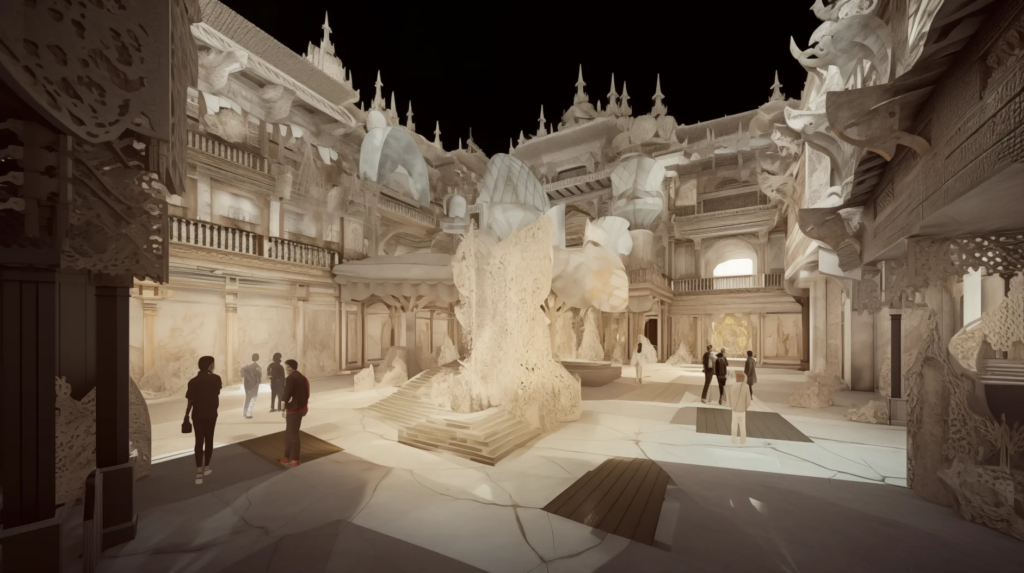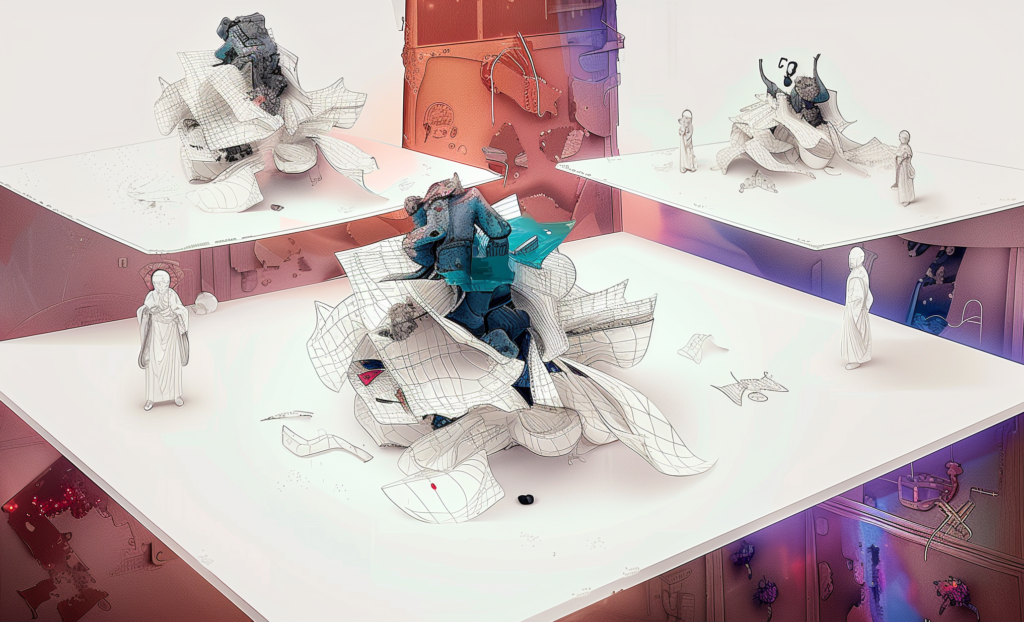SINO-VIRTUALITY: ABSTRACTION, IMMERSIVITY, AND INTERACTIVITY IN MEDIA ECOLOGY – PROVIDES NG
AN ARCHITECTURAL INVESTIGATION OF XIQU AND LIVE ACTION ROLE PLAY (LARP)
Virtuality, the state of existing in a non-physical manner, is a concept that can be interpreted in various contexts. Ancient Greek philosophy views perfection as existing solely in virtuality, it is a reality that is abstracted from measure. In the context of art, virtuality describes the interaction between the spectator and the artwork, generating a sense of interactivity at the socio-psychological level. In the realm of technology, virtuality encompasses the use of immersive computing devices, including virtual reality (VR) and algorithmic simulations. The diverse interpretations of virtuality contribute to new forms of communication deeply rooted in the historical evolution of human culture, perception, and the (un)structuring of societal value.

In the context of Chinese culture, Xiqu (Chinese opera) has a rich history of blending performance, music, and visual arts to create a multisensory experience for audiences. The fusion of these traditional art forms with contemporary technologies has opened up new avenues for cultural interpretation and audience engagement. Furthermore, Live Action Role Play (LARP), a form of interactive storytelling that allows participants to immerse themselves in fictional worlds, offers a unique platform for creative expression and social interaction. The emergence of these immersive experiences has redefined boundaries between reality and virtuality in contemporary media ecology.

What stands at the intersection is the long culture of Chinese art to emphasise the capturing and cultivating of essence 精, qi 氣, and spirit 神, without necessarily a realistic depiction of objects, figures and scenes – the art of abstraction. For instance, Xiqu depicts thousands of horses and soldiers in a contained stage space; or how LARP simulates the grandeur of a Chinese palace within a modestly decorated room. By investigating how traditional and contemporary forms of performance art intersect, this study aims to harness a deeper understanding of virtuality and its implications for contemporary media practices. How do Chinese Xiqu and LARP utilise abstraction to enhance immersivity and interactivity, and what principles can be derived from these practices for the design of new virtual environments?

The study has the objectives 1) to examine at how Xiqu and LARP consumes and configure its environment and spaces to perform abstraction, 2) to study the role abstraction plays in enhancing immersivity and interactivity, 3) to understand how these aspects give form to a virtuality that blurs the boundary between spectators and participants, and 4) to abstract principles that can be operationalised to inform the design of virtual environments.
Delving into the spatio-architectural aspects of Xiqu and LARP, the reflections of this study bridge the gap between traditional art forms and contemporary digital practices, shedding light on ways in which cultural heritage can inform the design of virtual experiences. Additionally, the cases documented offer valuable insights into the evolving landscape of media consumption and audience engagement in contemporary China, fusing the larger dialogue on cultural, social, and technological implications of media ecology through the diverse manifestations of a Sino-Virtuality.
Provides Ng is an architecture designer and researcher, known for her work at the intersection of cybernetics theory, immersive technology, decentralisation, and participatory design. Currently pursuing her PhD at CUHK, she is a Lecturer at the Bartlett School of Architecture (UCL), Treasurer of The Association for Computer-Aided Architectural Design Research in Asia (CAADRIA), and Managing Editor of B-pro Prospectives Journal (interim). Provides conducted research at Strelka Institute Moscow, and is an alumnus of Städelschule Architecture Class (SAC) Germany. She co-founded two international R&D collectives, specialising in the application of artificial intelligence (AI) to volumetric cinema and bio-inspired design: Current.cam and R.E.Ar_. Her research has received accolades including SIGraDi 2021 ‘Best Presentation Award’, Silver Prize in Educational Technology at TLI Expo 2022 and more. She has been invited to lead workshops at esteemed institutions like CumInCAD Conferences, Matadero MediaLab Madrid, and SCI-Arc. Her work has been exhibited worldwide at Rijksmuseum Twenthe, Multimedia Art Museum Moscow, The Bi-City Biennale of Urbanism/Architecture and other renowned venues.
The lecture wiill happen online on Thursday 01/07 at 3PM CET, please register here: https://events.teams.microsoft.com/event/34468fe9-56a5-4577-91c3-a363d6e9f7da@3973589b-9e40-4eb5-800e-b0b6383d1621
The lecture series is moderated and curated by prof. Corneel Cannaerts, Fieldstation Studio Ghent, KU Leuven Faculty of Architecture



